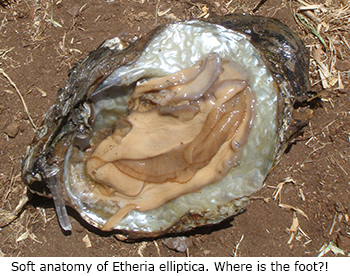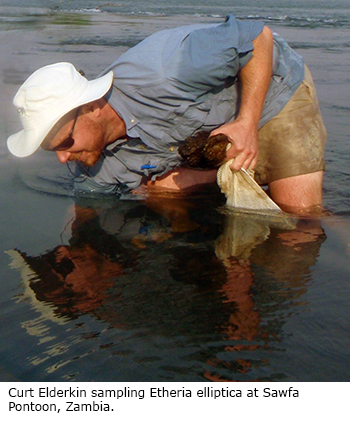Etheria elliptica was first given the spotlight as Mussel of the Month way back in September 2003 — it was the 2nd freshwater mussel so honored by us. But, 2003 was forever ago and pre-dates YouTube.com, Facebook.com, and Graf & Cummings (2006, 2007), for crying out loud! Moreover, the early online edition of a forthcoming paper by Elderkin et al. (2016) highlights the need to re-examine this species. E. elliptica also exhibits such highly divergent morphologies that it certainly merits two pictures on this list.
 Etheria elliptica is the sole Afrotropical species of the Etheriidae, the cementing freshwater oysters. It has been hypothesized that it is the only species of the Etheriidae and that the other oyster-types are the result of convergent evolution, but we have beat that topic to death under previous monthly mussel entries (Acostaea rivolii, Pseudomulleria dalyi, Bartlettia stefanensis), as well as in print (Graf & Cummings, 2009, 2010). Classification aside, E. elliptica is a very oyster-like freshwater mussel. Though dimyarian,* the foot is highly reduced, reflecting the shift from the mostly sedentary life-style of most freshwater mussels to the completely sessile habit of oysters cemented to their substrate. Etheria elliptica is the sole Afrotropical species of the Etheriidae, the cementing freshwater oysters. It has been hypothesized that it is the only species of the Etheriidae and that the other oyster-types are the result of convergent evolution, but we have beat that topic to death under previous monthly mussel entries (Acostaea rivolii, Pseudomulleria dalyi, Bartlettia stefanensis), as well as in print (Graf & Cummings, 2009, 2010). Classification aside, E. elliptica is a very oyster-like freshwater mussel. Though dimyarian,* the foot is highly reduced, reflecting the shift from the mostly sedentary life-style of most freshwater mussels to the completely sessile habit of oysters cemented to their substrate.
Etheria elliptica (as currently classified) has the broadest geographical range of any Afrotropical freshwater mussel species, reported from 38 freshwater ecoregions in both Africa and Madagascar (Graf & Cummings, 2011).** Given such a wide distribution and its high degree of shell polymorphism (i.e, compare the specimen figured here with the one from our previous E. elliptica entry), it would be fair to assume that the current taxonomy of E. elliptica is “lumped” — that is, the taxonomy recognizes fewer species than actually exist in nature. Recently there are more data that suggest we might need to do some “splitting.”
 Bauer (2013) hypothesized two distinct but sympatric populations of E. elliptica in the upper Blue Nile based on differences in brooding pattern, and now Elderkin et al. (2013) have found at least three cryptic species in the Congo Basin using phylogenetic methods. What about West Africa? If the Etheria in the Niger, Volta or other rivers also harbors reproductively and/or genetically distinct lineages, there may be multiple species carving up the broad distribution of the genus! This could have implications for the prioritization of conservation efforts since species with smaller ranges face higher risks of extinction. Bauer (2013) hypothesized two distinct but sympatric populations of E. elliptica in the upper Blue Nile based on differences in brooding pattern, and now Elderkin et al. (2013) have found at least three cryptic species in the Congo Basin using phylogenetic methods. What about West Africa? If the Etheria in the Niger, Volta or other rivers also harbors reproductively and/or genetically distinct lineages, there may be multiple species carving up the broad distribution of the genus! This could have implications for the prioritization of conservation efforts since species with smaller ranges face higher risks of extinction.
We were there with Dr. Elderkin in Zambia in 2008 when he sampled some of the specimens that he and his colleagues used for this study, and we are glad that this work is now available. Congratulations to Curt et al.!
-----
* Marine oysters are monomyarian — they have only a single adductor muscle rather than two like most bivalves. The other freshwater oysters, Acostaea and Pseudomulleria, are monomyarian.
** The next-most widespread mussel is Chambardia wahlbergi from 25 ecoregions, though absent from Madagascar.***
*** The IUCN Red List reported that E. elliptica may have been extirpated from Madagascar, but see Graf & Cummings (2009) or click here for a review of the evidence that it ever actually inhabited that island.

Etheria elliptica in situ in the Chambeshi River, Zambia.
|